Solar eclipse of February 3, 1916
| Solar eclipse of February 3, 1916 | |
|---|---|
 Map | |
| Type of eclipse | |
| Nature | Total |
| Gamma | 0.4987 |
| Magnitude | 1.028 |
| Maximum eclipse | |
| Duration | 156 sec (2 m 36 s) |
| Coordinates | 11°06′N 67°42′W / 11.1°N 67.7°W |
| Max. width of band | 108 km (67 mi) |
| Times (UTC) | |
| Greatest eclipse | 16:00:21 |
| References | |
| Saros | 139 (24 of 71) |
| Catalog # (SE5000) | 9317 |
A total solar eclipse occurred on February 3, 1916. A solar eclipse occurs when the Moon passes between Earth and the Sun, thereby totally or partly obscuring the image of the Sun for a viewer on Earth. A total solar eclipse occurs when the Moon's apparent diameter is larger than the Sun's, blocking all direct sunlight, turning day into darkness. Totality occurs in a narrow path across Earth's surface, with the partial solar eclipse visible over a surrounding region thousands of kilometres wide. It was visible in Venezuela.
Related eclipses
Solar eclipse 1913-1917
Each member in a semester series of solar eclipses repeats approximately every 177 days and 4 hours (a semester) at alternating nodes of the Moon's orbit.
| Descending node | Ascending node | |||
|---|---|---|---|---|
| 114 | August 31, 1913 Partial |
119 | February 25, 1914 Annular | |
| 124 | August 21, 1914 Total |
129 | February 14, 1915 Annular | |
| 134 | August 10, 1915 Annular |
139 | February 3, 1916 Total | |
| 144 | July 30, 1916 Annular |
149 | January 23, 1917 Partial | |
| 154 | July 19, 1917 Partial | |||
Saros 139
It is a part of saros series 139, repeating every 18 years, 11 days, containing 71 events. The series started with partial solar eclipse on May 17, 1501. It contains hybrid eclipses on August 11, 1627 through December 9, 1825 and total eclipses from December 21, 1843 through March 26, 2601. The series ends at member 71 as a partial eclipse on July 3, 2763. Members in the same column are one exeligmos apart and thus occur in the same geographic area.
The solar eclipse of June 13, 2132 will be the longest total solar eclipse since July 11, 1991 at 6 minutes, 55 seconds.
The longest duration of totality will be produced by member 39 at 7 minutes, 29 seconds on July 16, 2186.[1] This is the longest solar eclipse computed between 4000BC and 6000AD.[2]
Series members 24-39 occur between 1901 and 2200:
| 24 | 25 | 26 |
|---|---|---|
 February 3, 1916 |
 February 14, 1934 |
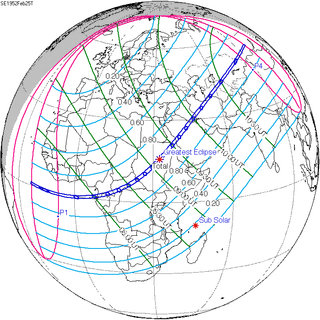 February 25, 1952 |
| 27 | 28 | 29 |
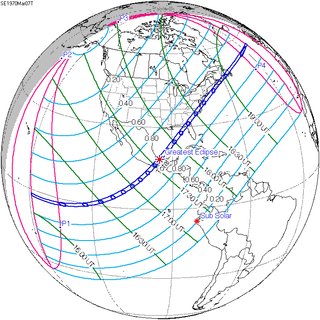 March 7, 1970 |
 March 18, 1988 |
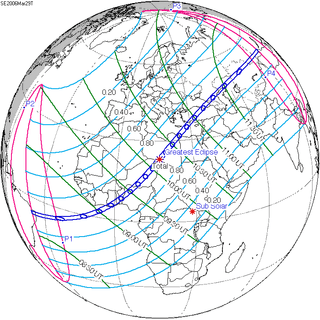 March 29, 2006 |
| 30 | 31 | 32 |
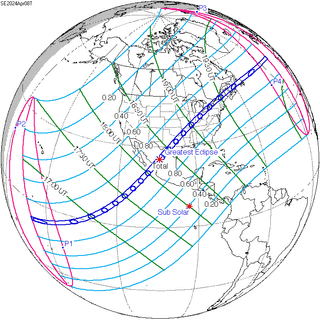 April 8, 2024 |
 April 20, 2042 |
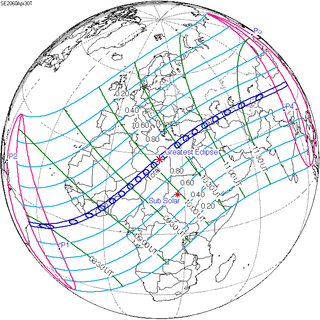 April 30, 2060 |
| 33 | 34 | 35 |
 May 11, 2078 |
 May 22, 2096 |
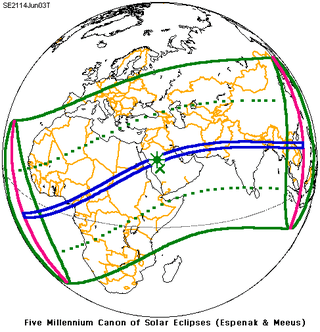 June 3, 2114 |
| 36 | 37 | 38 |
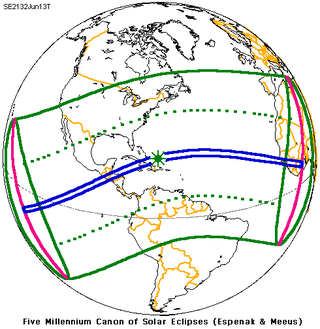 June 13, 2132 |
 June 25, 2150 |
 July 5, 2168 |
| 39 | ||
 July 16, 2186 |
Notess
- ↑ Saros Series Catalog of Solar Eclipses NASA Eclipse Web Site
- ↑ Ten Millennium Catalog of Long Solar Eclipses, -3999 to +6000 (4000 BCE to 6000 CE) Fred Espinak
References
- Eclipse data, NASA
- Optical Response of the Atmosphere During the Caribbean Total Solar Eclipses of 26 February 1998 and of 3 February 1916 at Falcón state, Venezuela, Journal Earth, Moon, and Planets, Volume 91, Number 3 / November, 2002

